This Article First Appeared in the June 2019 issue of Southern Calls
(Photos by Andrew Tawes and Courtesy of Southern Calls)
__
Waterman’s Cortege
by: Todd Harra
“Around here, captaining is something passed down from generation to generation,” says Robert H. “Bob” Bradshaw Jr., owner of Bradshaw & Sons Funeral Home in Crisfield, Maryland. “I think it’s in the blood.” He pauses and adds, “Like undertaking.”
Nestled in the windswept shores of the Lower Eastern Shore is the sleepy town of Crisfield where the Bradshaw family has served the community for six generations. And for 134 years Bob Bradshaw and his family have carried out one of the most unique burial traditions in America. Ten miles off the coast of Crisfield are Smith and Tangier Islands. When a resident of one of these isolated islands dies, Bradshaw & Sons is called out into the Chesapeake Bay to bury their dead.

The Bradshaw family dynasty began during the particularly frigid winter of 1885 when Captain Aaron B. Bradshaw’s wife Laura died during childbirth at the age of 26. Aaron was a fruit farmer, owning a homestead named Pitchcroft in the village of Ewell (the locals pronounce it “yule”) on the western side of Smith Island. The Chesapeake was frozen solid and getting to the mainland for wood to build a coffin was out of the question. Aaron knew of a waterman in the village of Tylerton who had “laid in” (or, for you non-watermen, was drying some cedar) in preparation for building a new boat. Normally, Tylerton is only accessible by boat but Aaron trudged the two miles of frozen marsh and creek to barter, and then dragged the lumber home. He buried Laura in Pitchcroft’s yard.
Not wanting his neighbors to undergo the same traumatic ordeal, Aaron circulated the word around the island he would help the community bury their dead. The workshop behind Pitchcroft became known as “The Coffin House” by the locals. Given his skill as a carpenter, Aaron was a tradesman undertaker, not an embalmer. When someone died he would fit them in a custom coffin and make preparations for burial in the local churchyard or on family land. Two family members would sit a death vigil throughout the night and at midnight the family gathered for a supper. In the winter windows were opened, or if it were one of the warmer months, Aaron supplied a corpse cooler.
After Aaron died in 1921, his son, John A., known as Captain Johnny, moved the business to the mainland. He opened Bradshaw Funeral Parlors over the Woodland Grocery Store on First Street in Crisfield in 1923. He didn’t need much room as services were generally conducted in homes and churches, and embalming was done solely in the home, a skill John learned by reading a book. Business was slow at first, as he was competing against the established firm of I.S. Lawson, and he survived by painting homes and churches.
The business did well enough that in 1929 John built an all brick establishment on Main Street. The business was on the first floor and there were apartments on the second and third floors that the family lived in and rented out to boarders.
Hurricane Hazel, a category 4 storm, swept up the coast on October 15, 1954, cutting a swath of destruction and leaving several feet of water in Bradshaw Funeral Parlors. John and his son, H. Harvey, and grandson, Robert H., decided it was time to move the business. They bought out Covington Funeral Home several blocks away. The original funeral home still stands on Main Street and is called Bradshaw Apartments.
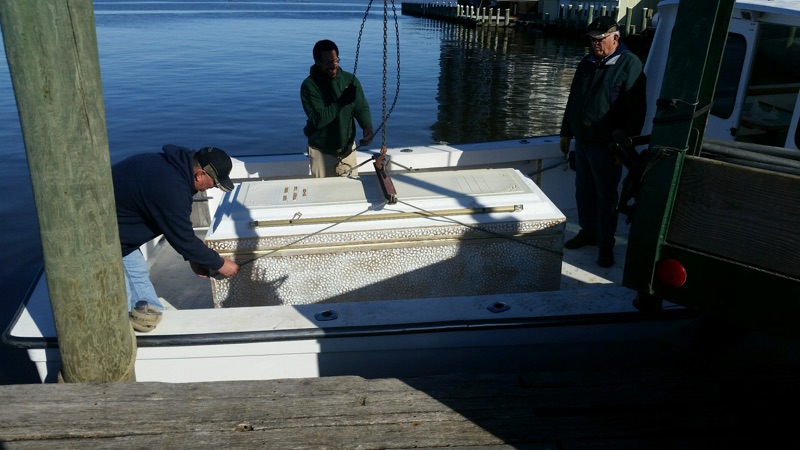
When John and his sons moved the business in 1955 they changed the name to Bradshaw & Sons Funeral Home. The stately Queen Anne Victorian is located in a shady section of West Main Street with a wraparound porch featuring a prominent witch’s hat roof on the corner turret. The black awnings covering the windows are reminiscent of a simpler time before central air, when folks cooled their homes with the bay’s breeze. Built in 1906 by the Dennis family, who owned a fish processing plant on Old Island, the house sits on a granite block foundation that may have been ship ballast – not uncommon in a port town.
The entrance foyer has retained its turn-of-the-century splendor, boasting original dark oak mouldings including magnificently carved iron scroll headers set in the door casings. The most prominent feature is a grand raised-panel staircase with a stained-glass window set at the landing. In the past seven decades several generations of Bradshaws have lived on the second floor.
Over the years, the family has improved and expanded the facility. Harvey bought the house next door in the ‘60’s and knocked it down to make a parking lot. They expanded the building by 5,000 square feet in 2003. “My dad designed the entire addition by himself sitting at his desk one sunny Sunday afternoon,” Bob says. “The architect said he missed his calling.” Robert Sr. was able to see the finished addition before his death in 2004. In the addition’s hallway there’s a small memorial to him; his fireman’s hat perched atop his Olympia manual typewriter. Robert Sr.’s plans doubled the size of the facility, allowing it to seat up to 250 people.
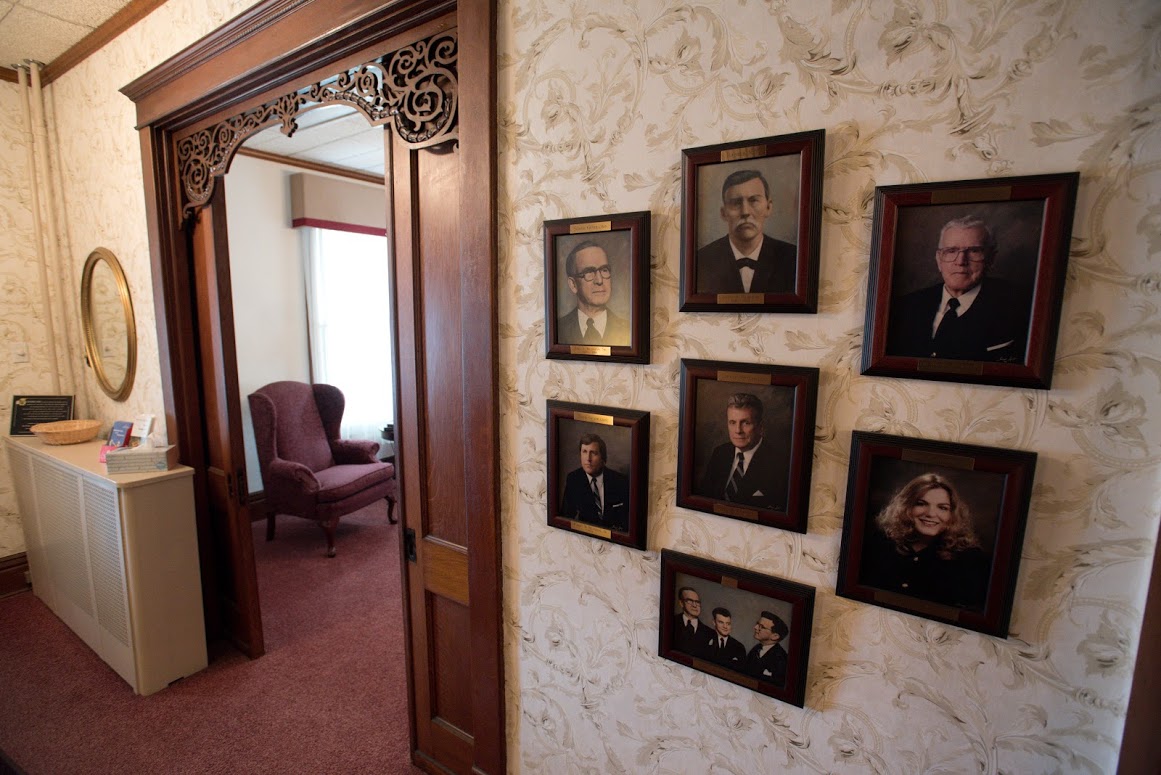
But not all the services take place in Bradshaw’s chapel, some take place 10 miles offshore.
Smith and Tangier Islands, located in the Tangier Sound, were discovered in 1608 by Captain John Smith (Smith Island ironically wasn’t named for Captain Smith, but an early landowner named Henry Smith) but weren’t settled for another half century. The islands have limited access to the mainland, being only accessible by boat or helicopter. Tangier Island boasts a small airstrip of 2,426 feet, long enough to accommodate small aircraft like a single engine Piper Cherokee. There is no town council, mayor, police force, or doctors on Smith Island. Tangier has a town council, a mayor, one sworn officer, and a medical center with a physician’s assistant. There are about 275 residents on Smith and 450 residents on Tangier Island.
Most of the island residents are watermen. Former Crisfield mayor, Kim Lawson, explained that the original settlers were farmers, but when the U.S. Navy began depth mapping the Chesapeake because their ironclads drew such a draft, they discovered an abundance of oyster beds. The Chesapeake Bay offers a steady, if not grueling, living for the watermen who crab and oyster.
“Used to be when my grandfather and great-grandfather received a call on the island they’d go out to the island and embalm the body. Day or night. That got to be too much. In the ‘60’s we told the residents they had to be brought back to the mainland and prepared. ” After that, the Bradshaws went on house calls to the islands to bring the dead back to the funeral home. “Now, the fire company responds to the call and I meet them at the dock with the coroner.”

For a time the populations of the islands were large enough that in 1931 Harvey commissioned the building of a 42 foot boat on Smith Island he named King Tut. It became known as the “Hearse Boat of the Chesapeake Bay” and could often be seen sailing up and down the bay with the Rotary Yacht Squadron. Harvey was such a prolific boater that Governor J. Millard Tawes bestowed upon him an honorary Admiralship of the Chesapeake.
For an island burial, the casket would be loaded on the King Tut and the flowers placed in special boxes to keep them from blowing around. The King Tut was sold in the ‘70’s, and now the caskets are sent over on the mail boat, the Island Belle II, to Smith Island or the Courtney Thomas to Tangier Island. There are two other boats that run a regular service to Smith Island, the Captain Jason and the Captain Jason II, and can accommodate a casket. “We always ask the families if they have a preference which boat their loved one goes on,” Bob says. If the bay is frozen, the casket is taken over on a state-owned icebreaker, the J. Millard Tawes.
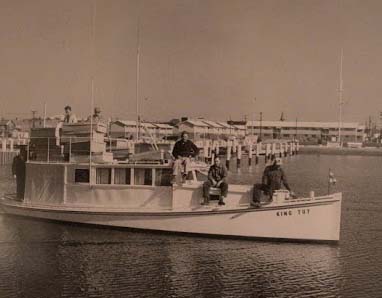
On Smith Island, a pickup truck meets the boat to take the casket to church. There are three churches on the island, all Methodist, one for each of the three villages. Rhodes Point is accessible from Ewell, but the village of Tylerton is isolated and only accessible by boat. Residents of the village help carry the casket into the church. “There are a lot of steps to get into these churches,” Bob says, “because of the high-water mark.” At Tangier Island the local ambulance is fitted with a roller tray and meets the Courtney Thomas at the dock to transport the casket.
On Smith Island, most residents are buried in the adjoining church yard of their parish. Tangier Island contains more private family cemeteries, meaning the ambulance is enlisted a second time if the cemetery is a distance from Swain Memorial Church. But that’s the only piece of motor equipment in the procession. The mourners all walk.
“Graves are dug by hand out on the islands,” Bob says. “And we lower caskets in the old-fashioned way,
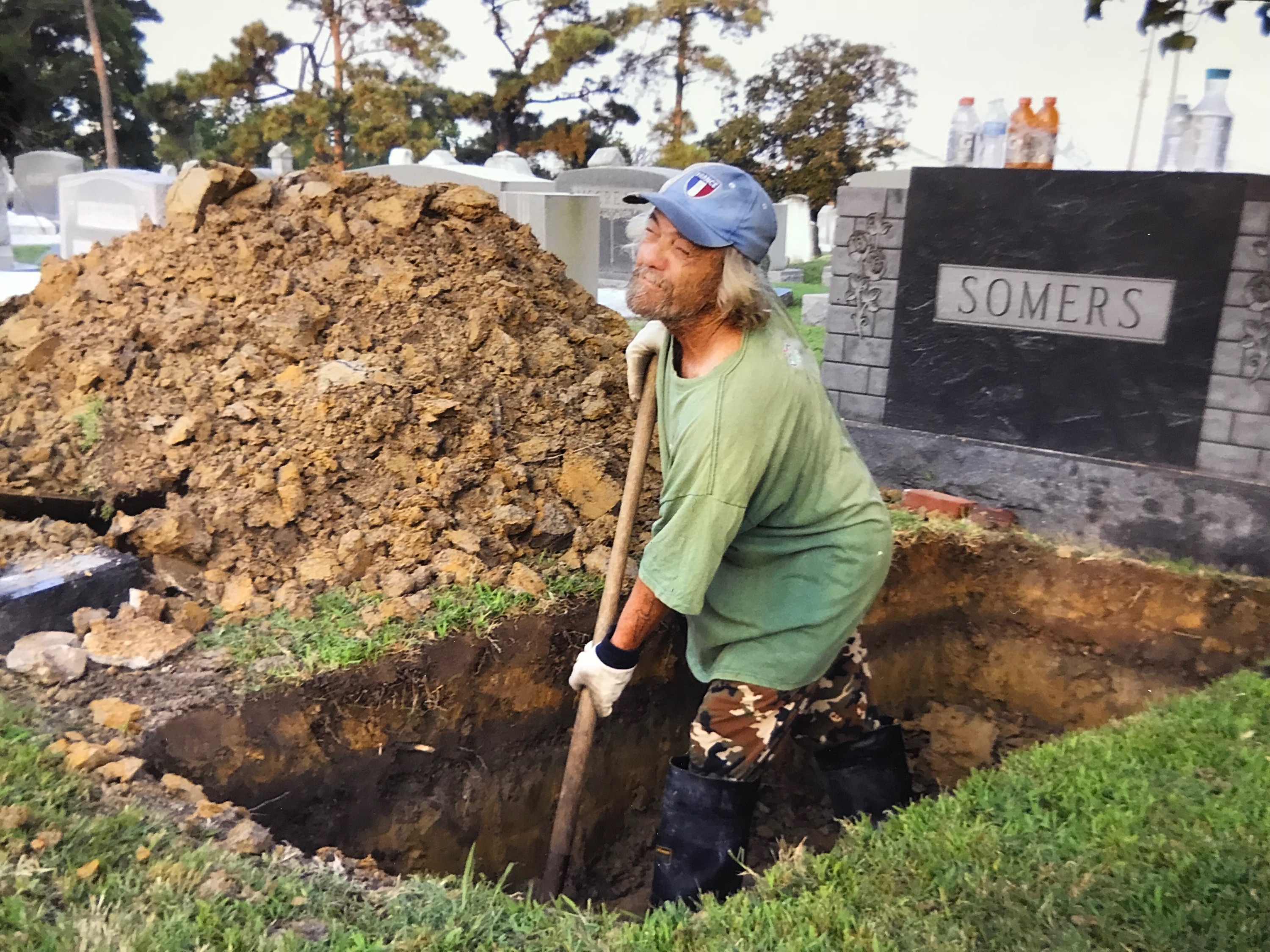
with ropes. It’d be tough to keep a lowering device in good working order out there.” He’s referring to the fact that the salt air is hard on things. The vaults – Bob uses Doric – are floated over on boats too; they’re loaded up at the county dock and sent separately from the casket. Because of the high-water table many of the older graves have exposed vault lids. They get buried completely underground now.
It’s midday and Crisfield’s city dock is busy. The locals call it “The Depot” owing to the fact that there used to be a rail depot running out onto the dock to haul the day’s catch inland. The mail boats are about to depart. They carry everything for the island residents: medicine, food, I even spy a brand new flat screen TV tucked away. Otis Ray Tyler, captain of the Island Belle II, stands on the dock, readying his boat. “I’ve been captaining for 35 years,” he tells me. “My family has had the mail contract for over a hundred.” Like many of the island residents, he speaks with the distinct dialect of Smith and Tangier Island. It’s a speech relic of Elizabethan English – specifically Cornwall County – that has perpetuated because of their isolated community, but has also spread to the mainland. I find myself stopping Bob occasionally to spell certain things. To the untrained ear it can be a bit hard to decipher.
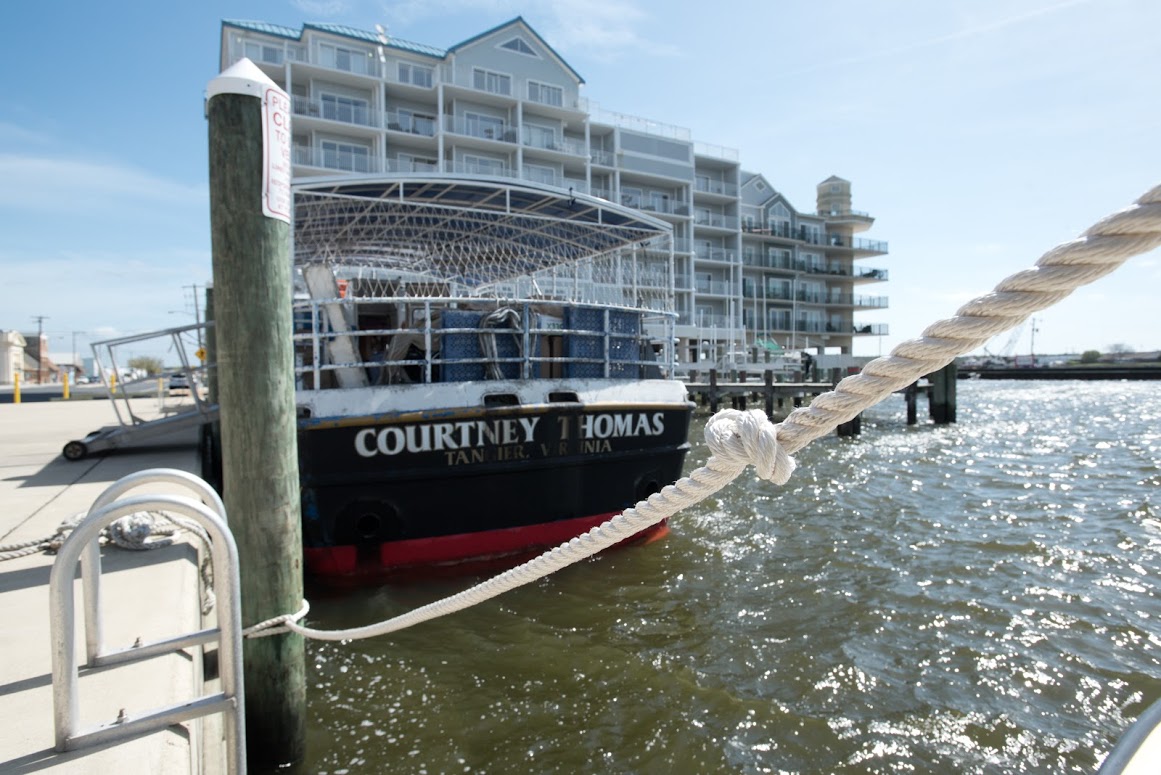
In two days, Captain Otis’s mother’s casket will be brought to the dock to be loaded on the Island Belle II for return to her home on Smith Island. Of course, Bob Bradshaw has been entrusted to conduct the funeral.
“I always knew this is what I wanted to do,” Bob says. “As soon as I turned 16 and got my driver’s license, that was it. I went on every removal. I had two phones in my room. A blue one for my friends to call me on and the red one was the business phone.” He laughs. “Kind of like the Batphone.”
Hanging on the wall of his office is a framed photo of a young Bob standing in front of the funeral home with the hearse and rest of the fleet lined up. Bob is mugging for the camera. “My yearbook photo,” he explains. Pointing to the young woman in the photo, he adds, “That was my girlfriend at the time. She’s now my wife.”
“The first person I ever embalmed solo was my great-grandmother.” Bob pauses. “That was tough, but my dad couldn’t do it, nor could my grandfather. Someone had to.”

Bob was the first person in his family to attend mortuary college. He graduated in 1975 from Catonsville Community College’s first graduating class. Over his career Bob has served on the State Board of Morticians and Funeral Directors, and is currently in his 3rd term on the state board.
In addition to their business, the Bradshaws have served their community through the fire company. John was a charter member of the Wildwood, New Jersey Fire Company, and Harvey served with the Pocomoke Fire Company during the short time in the ‘30’s and 40’s when the Bradshaws had a funeral home in the neighboring town. Robert Sr. was a lifetime member of Crisfield Fire Company, and Bob is the deputy chief, having served 44 years. During the day I spend with Bob, the radio on his belt occasionally came to life. He’d cock an ear, listen, and then silence it.
His assistant, Frankie Pruitt – a Tangier Island native – is the chief of Station 2. “When we’re at work I’m boss,” Bob says, “but at the fire house, he’s the boss.”
Firefighting isn’t the only First Responder mantle Bob has worn. Like many funeral homes, Bradshaw & Sons provided ambulance service in Crisfield for decades. When they discontinued the service in the early ‘60’s, the local hospital took over. Later, when Bob saw a need for reliable emergency transportation he helped found the Somerset Ambulance Squad in 1980.
Bob has dedicated almost a half century to the family business and can rest soundly in the knowledge that the tradition of Bradshaw & Sons will continue with his daughter, Mary Beth Bradshaw. Like her father, she knew she wanted to go into the business from an early age. As a high school senior she completed a work-study program under her dad’s tutelage. She would often be caught with her ear to the arrangement conference room. Laughing while Mary Beth blushes, Bob says, “I’d say, ‘Go on in there and tell your grandfather you want to sit in!’” Mary Beth graduated from Catonsville in 1998 and has been with the firm ever since. And she’s certainly not the first woman in the business. Her great-great grandmother, Evelyn D. Bradshaw became one of the first licensed morticians in Maryland in 1921.
When asked about his plans for the future Bob says, “My retirement party will be my funeral. I can’t imagine not working. There’s such a great satisfaction to what I do.” And maybe he’s right that he can’t give it up, because undertaking is indeed in his blood.

A special thank you to Dave Salmon of Warfield-Rohr Casket Co. for cluing the author in to this unique burial tradition.
